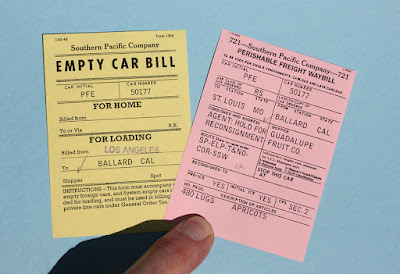Railroad employees often called them speeders or motor cars; the railroad I model, Southern Pacific, called them “track cars” in official documents. I posted about a beautiful 3D-printed Fairmont speeder in HO scale awhile back (see it at: https://modelingthesp.blogspot.com/2022/07/a-beautiful-ho-scale-speeder.html ) and showed it in place on my layout. It was produced by Yelton Models, located in Niagara Falls, Ontario.
More recently, a Fairmont M-19 speeder in HO scale was 3D-print produced by Ken Harstine (I believe doing business as Voltscooter), in three versions: with a windscreen and a seat, with windscreen only, and with neither seat nor screen. Below is a photo from Tim O'Connor showing such cars. This view was taken at Beaumont, Texas in 1976.
The one in the rear in this view is enclosed, like the Yelton one I showed in the post linked in the top paragraph, above. The foreground car, without seat or screen, is the type sometimes called a “gang car,” as it might be used by track gangs. The middle speeder has a windscreen (of a later design including clear windshield in the upper part) but no seat. Note that these cars have fenders on the wheels, an optional feature on Fairmont speeders.
Here is the simplest speeder, much like the “gang car” shown above, with neither windscreen nor operator seat, seen at the speeder shed in my layout town of Ballard. Beyond the shed is an SP concrete phone booth. Like all my speeder models, it’s painted Daylight Orange. Wheels are grimy black.
Addition of a windscreen makes a speeder like the center car in the prototype photo above, but with the early style of a screen only, no windshield. It’s at the speeder pull-out or turnout near the mainline tunnel on the approach to Shumala on my layout. Note that it does have the handles that a crew can use to manhandle it on and off the track. (I described building SP-style turnouts like this in a post awhile back; see it at: : https://modelingthesp.blogspot.com/2019/01/track-car-turnouts-part-4-installation.html ).
These speeder models are provided with decals for diagonal black stripes on the front. From what I know, these stripes were used in later years, but I have not found a photo showing such stripes on speeders in the early 1950s. Thus my models don’t have them.
Here’s a close-up view from the rear of the type shown above. It’s impressive what has been modeled here; this is a really small model. The width of the windscreen shown below is just 9/16 of an inch.
The third type is like the one above, but with an operator seat. Note the motor controls in the center housing, included on all these speeder models. It’s shown on the pull-out near the depot in my layout town of Santa Rosalia. In the background is the trailer containing the Harbormaster’s office for the port.
These are all nice models for period “atmosphere,” and I can change them from pull-out to pull-out so they don’t become scenery fixtures.
Tony Thompson
































